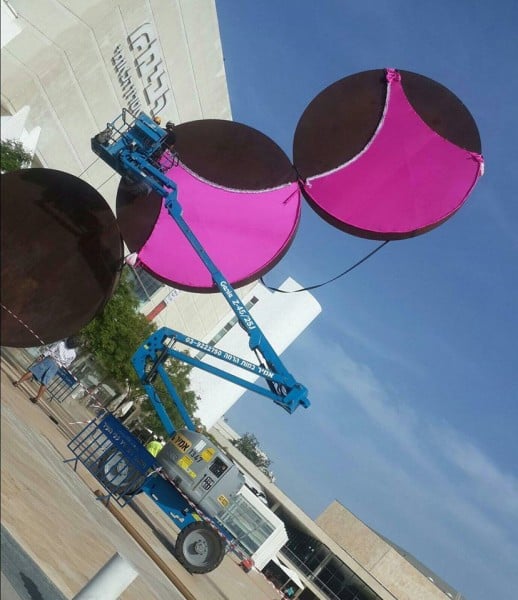Law & Politics
Mayor of Tel Aviv Puts Pink Bra on Public Sculpture—What?
Becuase the road to hell is paved with good intentions.

Photo: via Time Out Tel Aviv
Becuase the road to hell is paved with good intentions.

by
Hili Perlson

The mayor of Tel Aviv, Israel, got a little too creative with a recent campaign to raise awareness of breast cancer when he ordered to place a hot pink bra on two of the three circles that make up the fifty-foot steel statue Hitromemut (Uprise) by the late Israeli sculptor and painter Menashe Kadishman.
The sculpture is located on HaBima Square (also known as The Orchestra Plaza), a public space in the center of the city linking two busy avenues. The square is home to a number of cultural institutions—such as the Habima Theater, the Fredric R. Mann Auditorium, and the Helena Rubinstein Pavilion for Contemporary Art—and the prominent artwork has become a symbol of the popular meeting point.

The sculpture by Menashe Kadishman on Habima Square, Tel Aviv-Yaffo
Photo: via commons.wikimedia.org
Though the sculpture’s centrality may have enticed the city to use it for a noble cause, the misguided action—not without sexist undertones—wasn’t met with much approval from the art community. Unsurprisingly.
“As part of the campaign to raise awareness of breast cancer the sculpture will be re-named from Uprise to Push-up,” one writer quipped in a comment after Time Out Tel Aviv posted an image of the dressed-up artwork on Facebook. “Kadishman must be turning in his grave,” read another comment.
Breast Cancer Awareness Month is being celebrated around the work, but the Tel Aviv debacle suggests it is best to create new artworks for the cause, rather than appropriating existing one. (In New York, an illuminated Pink Lotus sculpture by Grimanesa Amorós promoting breast cancer awareness is among the city’s best seasonal public art.)
Menashe Kadishman, who passed away in May at the age of 82, was one of Israel’s most well-known artists. He represented the country at the 1978 Venice Biennale and his public pieces are installed in squares throughout Israel and in numerous countries around the world, including the US, Canada, Germany, and Japan.
He is perhaps most recognized for his motif of the sheep, which appeared in many of his semi-abstract paintings, and that draws from the biblical story of the Binding of Isaac.
The sculpture Uprise was made between 1967-1976 and addresses the high inflation and economic instability in Israel in those years.